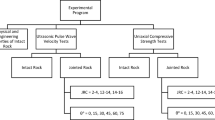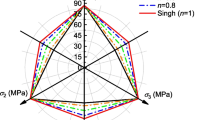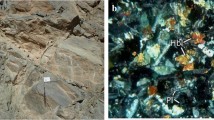Abstract
Wave velocity as a nondestructive test is widely used in various fields such as mining, civil, rock mechanics and rock engineering, and dynamic elastic properties of rocks are also determined by wave velocity. Rock mass contains discontinuities with different orientation angles, numbers of sets and frequencies and the impacts of such discontinuity properties on the wave velocity have not yet been systematically investigated. In this study, 20 groups of jointed cylindrical specimens with a wide range of discontinuity orientation angles (0°, 30°, 45°, 60° and 90°), numbers of sets and frequencies were prepared, and their P-wave velocities were measured. P-wave velocity (VP) significantly increased with increasing orientation angle (θ) and decreasing the discontinuity frequency (F). Several relations were applied to analyze the results. Finally, a new empirical relation was developed to predict VP as a function of θ angle using two parameters of P-wave velocity perpendicular to the discontinuity plane (VP0°) and P-wave velocity along the discontinuity direction (VP90°) or anisotropy degree (ε = (VP90° − VP0°)/VP0°) with a good correlation of determination (R2 = 0.933), low RMSE (RMSE = 200.0 m/s) and low CV (CV = 6.7%). A good correlation between VP and F was also achieved for the test results. The intact rock elements in the complex nature of a rock mass are surrounded by discontinuities like a three dimensional puzzle. Treatment of such a rock mass system using cement grouting is an attractive method to improve its quality for various purposes. All 20 groups of jointed cylindrical specimens were grouted by cement. Wave velocities of the grouted specimens were measured after 2 months. VP significantly increased after grouting for all models of jointed specimens, as wave velocity of jointed specimens improved and approached to the wave velocity of the intact rock for most cases. The discontinuity orientation of the specimens had no significant effect on the wave velocities after grouting. But the results showed that VP and VS increased little with increasing orientation angle for jointed specimens consisting only of one set of discontinuity. After grouting the jointed specimens, orientation angle and frequency of discontinuities had also similar effects on the dynamic Young's modulus (E), Poisson's ratio (ν), shear modulus (μ), bulk modulus (K) and Lamé’s constant (λ). These results also showed that the dynamic elastic properties of jointed specimens significantly improved using cement grouting.



















Similar content being viewed by others
Abbreviations
- V P :
-
P-wave velocity in m/s
- V S :
-
S-wave velocity in m/s
- E :
-
Dynamic elastic modulus in GPa
- μ :
-
Dynamic shear modulus in GPa
- ν :
-
Dynamic Poisson's ratio
- K :
-
Dynamic bulk modulus in GPa
- λ :
-
Dynamic Lamé's constant in GPa
- θ :
-
Angle between the axis of symmetry (perpendicular to weakness planes) with the wave propagation direction
- V P0 ° :
-
P-wave velocity perpendicular to the discontinuity plane in m/s e
- F :
-
Frequency of discontinuities in (1/cm)
- V Pi :
-
P-wave velocity of intact rock
- \(V_{{{\text{P}}90^\circ }}^{{}}\) :
-
P-wave velocity along the discontinuity direction in m/s
- \(V_{{{\text{S}}0^\circ }}^{{}}\) :
-
S-wave velocity perpendicular to the discontinuity plane in m/s e
- \(V_{{{\text{S}}90^\circ }}^{{}}\) :
-
S-wave velocity along the discontinuity direction in m/s
- ε :
-
Anisotropy parameter that is the percentage change of \(V_{{{\text{P}}90^\circ }}^{{}}\) with respect to \(V_{{{\text{P}}0^\circ }}^{{}}\)
- γ :
-
Anisotropy parameter that is the percentage change of \(V_{{{\text{S}}90^\circ }}^{{}}\) with respect to \(V_{{{\text{S}}0^\circ }}^{{}}\)
- δ :
-
Anellipticity of the P-wave curve
- ρ :
-
Bulk density gr/cm3
- K :
-
A constant coefficient
- a :
-
A constant coefficient
- b :
-
A constant coefficient
- VTI:
-
Transverse isotropic symmetry
References
Abdi Y, Khanlari GR, Jamshidi A (2018) Correlation between mechanical properties of sandstones and P-wave velocity in different degrees of saturation. Geotech Geol Eng. https://doi.org/10.1007/s10706-018-0721-6
Ajalloeian R, Jamshidi A, Khorasani R (2020) Assessments of ultrasonic pulse velocity and dynamic elastic constants of granitic rocks using petrographic characteristics. Geotech Geol Eng 38:2835–2844. https://doi.org/10.1007/s10706-020-01189-6
Altindag R (2012) Correlation between P-wave velocity and some mechanical properties for sedimentary rocks. S Afr Inst Min Metall 112:229–237
Anderson DL, Minster B, Cole D (1974) The effect of oriented cracks on seismic velocities. J Geophys Res 79:4011–4015
Aydin A (2014) Upgraded ISRM suggested method for determining sound velocity by ultrasonic pulse transmission technique. Rock Mech Rock Eng 47:255–259. https://doi.org/10.1007/s00603-013-0454-z
Azimian A, Ajalloeian R, Fatehi L (2014) An empirical correlation of uniaxial compressive strength with P-wave velocity and point load strength index on marly rocks using statistical method. Geotech Geol Eng 32:205. https://doi.org/10.1007/s10706-013-9703-x
Azizi A, Moomivand H (2021) A new approach to represent impact of discontinuity spacing and rock mass description on the median fragment size of blasted rocks using image analysis of rock mass. J Rock Mech Rock Eng 54:2013–2038. https://doi.org/10.1007/s00603-020-02360-4
Babuška V (1981) Anisotropy of Vp and Vs in rock-forming minerals. J Geophys 50:1–6
Backus GE (1962) Long-wave elastic anisotropy produced by horizontal layering. J Geophys Res 67(442):7–4440
Barton N (2007) Rock quality, seismic velocity, attenuation and anisotropy. Taylor & Francis Group, London, p 756
Ben Ismaïl W, Mainprice D (1998) An olivine fabric database: an overview of upper mantle fabrics and seismic anisotropy. Tectonophysics 296:145–157
Byun J-H, Lee J-S, Park K, Yoon H-K (2015) Prediction of crack density in porous-cracked rocks from elastic wave velocities. J Appl Geophys 115:110–119. https://doi.org/10.1016/j.jappgeo.2015.02.020
Chawre B (2018) Correlations between ultrasonic pulse wave velocities and rock properties of quartz-mica schist. J Rock Mech Geotech Eng 10(3):594–602
Chen X, Xu Z (2017) The ultrasonic P-wave velocity-stress relationship of rocks and its application. Bull Eng Geol Environ 76:661–669. https://doi.org/10.1007/s10064-016-0866-6
Cholach PY, Schmitt DR (2006) Intrinsic elasticity of a textured transversely isotropic muscovite aggregate: comparisons to the seismic anisotropy of schists and shales. J Geophys Res 111:410–427
Crampin S, Kirkwood SC (1981) Velocity variation in systems of anisotropic symmetry. J Geophys 49:35–42
Crampin S, McGonigle R, Bamford D (1980) Estimating crack parameters from observations of P-wave velocity anisotropy. Geophysics 46:345–360
Fener M, Kahraman S, Bilgil A, Gunaydin O (2005) A comparative evaluation of indirect methods to estimate the compressive strength of rocks. Rock Mech Rock Eng 38(4):329–334
Gladwin MT (1982) Ultrasonic stress monitoring tunnel underground mining. Int J Rock Mech Min Sci 19:221–228
González J, Saldaña AJ (2019) Analytical model for predicting the UCS from P-wave velocity, density, and porosity on saturated limestone. Appl Sci 9(23):5265. https://doi.org/10.3390/app9235265
Heidari M, Mohseni H, Jalali SH (2017) Prediction of uniaxial compressive strength of some sedimentary rocks by fuzzy and regression models. Geotech Geol Eng 36:401. https://doi.org/10.1007/s10706-017-0334-5
Heidari M, Ajalloeian R, Ghazifard A, Hashemi Isfahanian M (2020) Evaluation of P and S wave velocities and their return energy of rock specimen at various lateral and axial stresses. Geotech Geol Eng 38:3253–3270. https://doi.org/10.1007/s10706-020-01221-9
ISRM (1978) Suggested methods for determining sound velocity International Society for Rock Mechanics Commission on standardization of laboratory and field tests. Int J Rock Mech Min Sci Geomech Abstr 15:53–58
Jin ZF, Li WX, Jin C, James H, Cusatis G (2018) Anisotropic elastic, strength, and fracture properties of Marcellus shale. Int J Rock Mech Min Sci 109:124–137
Kahraman S (2001) Evaluation of simple methods for assessing the uniaxial compressive strength of rock. Int J Rock Mech Min Sci 38:981–994. https://doi.org/10.1016/S1365-1609(01)00039-9
Kahraman S, Yeken T (2008) Determination of physical properties of carbonate rocks from P-wave velocity. Bull Eng Geol Environ 67:277–281. https://doi.org/10.1007/s10064-008-0139-0
Karpuz C, Paşamehmetoğlu AG (1997) Field characterization of weathered Ankara andasites. Eng Geol 46:1–17
Kern H (1978) The effect of high temperature and high confining pressure on compressional wave velocities in quartz-bearing and quartz-free igneous and metamorphic rocks. Tectonophysics 44:185–203
Kern H (1990) Laboratory seismic measurements: an aid in the interpretation of seismic field data. Terra Nova 2:617–628
Khandelwal M (2013) Correlating P-wave velocity with the physico-mechanical properties of different rocks. Pure Appl Geophys 170:507–514. https://doi.org/10.1007/s00024-012-0556-7
Kim H, Cho JW, Song I, Min KB (2012) Anisotropy of elastic moduli, P-wave velocities and thermal conductivities of Asan Gneiss Boryeong Shale and Yeoncheon Schist in Korea. Eng Geol 147:68–77
Li X, Lei X, Li Q (2018) Response of velocity anisotropy of shale under isotropic and anisotropic stress fields. Rock Mech Rock Eng 51:695–711. https://doi.org/10.1007/s00603-017-1356-2
Li K, Cheng Y, Yin Z et al (2020) Size effects in a transversely isotropic rock under brazilian tests: laboratory testing. Rock Mech Rock Eng 53:2623–2642. https://doi.org/10.1007/s00603-020-02058-7
Li X, Lei X, Li Q, Chen D (2021) Influence of bedding structure on stress-induced elastic wave anisotropy in tight sandstones. J Rock Mech Geotech Eng 13:98–113. https://doi.org/10.1016/j.jrmge.2020.06.003
Ma T, Peng N, Zhu Z, Zhang Q, Yang C, Zhao J (2018) Brazilian tensile strength of anisotropic rocks: review and new insights. Energies 11:304. https://doi.org/10.3390/en11020304
Nikrouz R, Moomivand H, Azad R (2016) Effect of foliation orientation on the P- and S-wave velocity anisotropies and dynamic elastic constants of the quartz-micaschists metamorphic rocks, Angouran mine. Iran Arab J Geosci 9:669. https://doi.org/10.1007/s12517-016-2699-9
Nur A (1971) Effects of stress on velocity anisotropy in rocks with cracks. Geophys Res 76:2022–2034
Oda M, Yamabe T, Kamemura K (1986) A crack tensor and its relation to wave velocity anisotropy in jointed rock masses. Int J Rock Mech Min Sci Geomech Abstr 23(6):387–397
Olona J, Pulgar A, Fernández-Viejo G, López-Fernández C, González-Cortina JM (2010) Weathering variations in a granitic massif and related geotechnical properties through seismic and electrical resistivity methods. Near Surf Geophys 8(6):585–599
Palmer D (2001) Measurement of rock fabric in shallow refraction seismology. Explor Geophys 32:307–314
Patella D, Patella SD (2009) Geophysical tomography in engineering geological applications: a mini-review with examples. Open Geol J 3:30–38
Ramamurthy T (2001) Shear strength response of some geological materials in triaxial compression. Int J Rock Mech Min 38:683–697
Ramamurthy T (2008) Joint factor concept in solving rock engineeering problems. 5th Asian Rock Mechanics Symposium (ARMS5) Tehran Iran 147–156
Sanchidrián JA, Ouchterlony F (2017) A distribution-free description of fragmentation by blasting based on dimensional analysis. Rock Mech Rock Eng 50:781–806. https://doi.org/10.1007/s00603-016-1131-9
Saroglou H, Marinos P, Tsiambaos G (2004) The anisotropic nature of selected metamorphic rocks from Greece. S Afr Inst Min Metall 104:217–222
Sarout J, Gueguen Y (2008) Anisotropy of elastic wave velocities in deformed shales: Part 1 – experimental results. Geophysics 73:75–89
Sharma PK, Singh TN (2008) A correlation between P-wave velocity, impact strength index, slake durability index and uniaxial compressive strength. Bull Eng Geol Environ 67:17–22. https://doi.org/10.1007/s10064-007-0109-y
Shen H, Li X, Li Q, Wang H (2020) A method to model the effect of pre-existing cracks on P-wave velocity in rocks. J Rock Mech Geotech Eng 12:493–506. https://doi.org/10.1016/j.jrmge.2019.10.001
Song I, Suh M (2014) Effects on foliation and microcracks on ultrasonic anisotropy in retrograde ultramafic and metamorphic rocks at shallow depths. J Appl Geophys 109:27–35
Sun C, Borgomano JVM, Fortin J, Wang S (2020) Effect of pore collapse and grain crushing on the frequency dependence of elastic wave velocities in a porous sandstone. Rock Mech Rock Eng 53:5081–5093. https://doi.org/10.1007/s00603-020-02213-0
Takanashi M, Nishizawa O, Kanagawa K, Yasunaga K (2001) Laboratory measurements of elastic anisotropy parameters for the exposed crustal rocks from the Hidaka metamorphic belt. Central Hokkaido Japan. Geophys J Intl 145:33–47
Thomsen L (1986) Weak elastic anisotropy. J Geophys 51:1954–1966
Tsvankin I (1997) Anisotropic parameters and P-wave velocity for orthorhombic media. J Geophys 62:1292–1309
Winterstein DF (1990) Velocity anisotropy terminology for geophysicist. Geophysics 55:1070–1088
Xu F, Yang C, Guo Y et al (2017) (2017) Effect of bedding planes on wave velocity and AE characteristics of the Longmaxi shale in China. Arab J Geosci 10:141. https://doi.org/10.1007/s12517-017-2943-y
Yang D, Li Q, Zhang L (2016) Propagation of pore pressure diffusion waves in saturated dual-porosity media (II). J Appl Phys 119:154901. https://doi.org/10.1063/1.4946832
Yasar E, Erdogan Y (2004) Correlating sound velocity with the density, compressive strength and Young’s modulus of carbonate rocks. Int J Rock Mech Min Sci 41:871–875. https://doi.org/10.1016/j.ijrmms.2004.01.012
Zhang L (2009) Estimating the strength of jointed rock masses. Rock Mech Rock Eng 43:391–402. https://doi.org/10.1007/s00603-009-0065-x
Zhang ZP, Wong LNY, Wang SJ, Han GY (2011) Engineering properties of quartz-mica schist. Eng Geol 121:135–149. https://doi.org/10.1016/j.enggeo.2011.04.020
Zhubayev A, Houben ME, Smeulders DMJ, Barnhoorn A (2016) Ultrasonic velocity and attenuation anisotropy of shales, Whitby, United Kingdom. Geophysics 81:45–56
Acknowledgements
The authors of this paper would like to thank Mr M. Moheb Houri technical officer of Rock Mechanics laboratory of Amirkabir University of Technology for his continual assistance in providing facilities for preparation and testing jointed rock specimens.
Author information
Authors and Affiliations
Corresponding author
Ethics declarations
Conflict of Interest
The authors declare that they have no conflict of interest.
Additional information
Publisher's Note
Springer Nature remains neutral with regard to jurisdictional claims in published maps and institutional affiliations.
Rights and permissions
About this article
Cite this article
Moomivand, H., Maarefvand, P. & Moomivand, H. A New Empirical Approach to Assess Wave Velocities and Dynamic Elastic Properties of Several Models of Jointed Rock Before and After Grouting. Rock Mech Rock Eng 54, 6439–6455 (2021). https://doi.org/10.1007/s00603-021-02625-6
Received:
Accepted:
Published:
Issue Date:
DOI: https://doi.org/10.1007/s00603-021-02625-6




